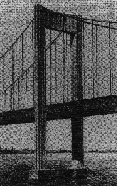 |
New York Architecture Images-New
York Bridges Roosevelt Island Bridge |
|
architect |
|
|
location |
connects Roosevelt Island to Long Island City in Queens |
|
date |
1955 |
|
style |
Structural Expressionism |
|
construction |
100 ft (30 m) of vertical clearance. It is 40 feet (12 m) wide, and its total length, including approaches, is 2,877 feet (877 m). The main span is 418 feet (127 m). |
|
type |
Bridge |
|
images |
  |
| The Roosevelt Island Bridge, crossing over the East Channel of the East River, in its closed position. Roosevelt Island is in the foreground, and the Manhattan skyline is in the background. RIGHT: The Roosevelt Island Bridge in its open position. The Con Edison plant in Long Island City, Queens is in the background. (Photos by New York City Department of Transportation.) | |
|
The Roosevelt Island Bridge is a lift bridge that
connects Roosevelt Island to Long Island City in Queens. It is the sole
route to the island for vehicular and foot traffic (without using public
transportation). Construction of the bridge began on March 17, 1952, at
a cost of $6.5 million. It opened in 1955 as the Welfare Island Bridge. When the bridge is open it provides ships with 100 ft (30 m) of vertical clearance. It is 40 feet (12 m) wide, and its total length, including approaches, is 2,877 feet (877 m). The main span is 418 feet (127 m). |
|
|
HISTORY OF ROOSEVELT
(WELFARE) ISLAND: What is known today as Roosevelt
Island was first purchased from the Algonquin Indians in 1637 by the
Dutch, who promptly renamed the island "Varckens Eylandt," or "Hog
Island." In the 1660's, the British reclaimed the island from the Dutch
after years of dispute. The island was granted to Captain John Manning,
the sheriff of New York. In 1673, Manning was sentenced to death (later
commuted to life imprisonment on the island) for relinquishing New
York's Fort James to the Dutch without a shot.
When Manning died in
1686, stepdaughter Mary Manningham renamed the island after her husband,
Robert Blackwell. Blackwell Island remained in private hands until 1828,
when the City of New York purchased it and transformed it into a setting
for mental institutions, hospitals and prisons. Reflecting this setting
as a repository for the down and out, the city renamed the property
Welfare Island in 1921. |
|
|
|
|